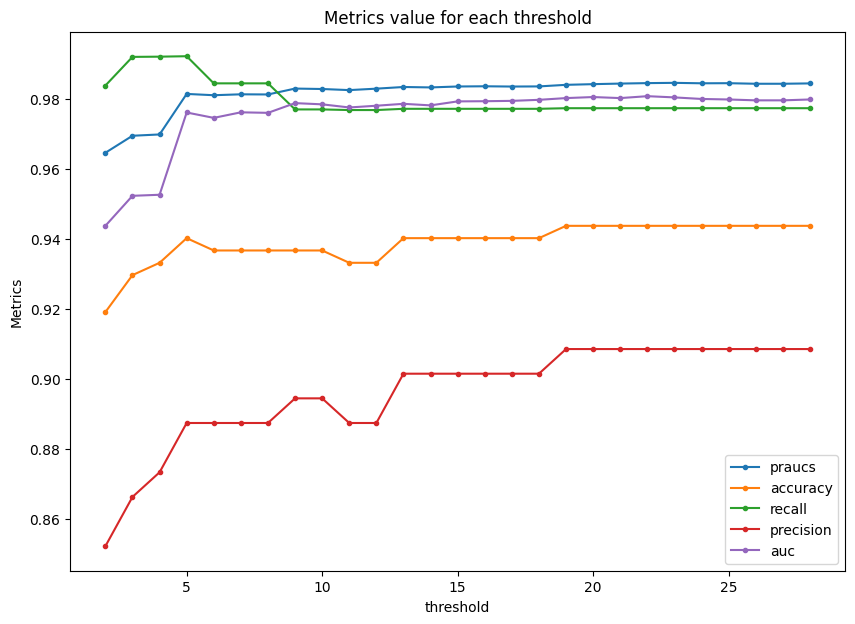Addressing Class Imbalance in Credit Card Fraud Detection: A Hybrid Deep Learning Approach
Keywords:
Credit card fraud detection, Deep Learning, GRU, LSTM, Smote-TomekAbstract
The rise of credit card fraud is a global concern, demanding reliable detection methods that can overcome challenges with imbalanced datasets and limited exploration of hybrid modeling approaches. This study introduces a hybrid deep learning architecture combining Gated Recurrent Unit (GRU) and Long Short-Term Memory (LSTM) layers alongside SMOTE-TOMEK preprocessing to address imbalanced data issues in credit card fraud detection. The research analyzes a substantial dataset containing both legitimate and fraudulent transactions, evaluating the performance of GRU, LSTM, and the novel Hybrid model through comprehensive data exploration, preprocessing, and feature selection. Performance evaluation uses metrics including accuracy, precision, recall, F1 Score, AUROC, and AUPRC. The experimental results demonstrate the effectiveness of deep learning architectures, with AUROC values of 0.974551 for LSTM, 0.958174 for GRU, and 0.976205 for the Hybrid model. The Hybrid model showed particularly promising results with a precision of 0.9121 and AUPRC of 0.886068, outperforming the individual models. These findings indicate that combining complementary deep learning architectures enhances fraud detection by leveraging their respective strengths in capturing both long-term dependencies and transaction patterns. These insights offer valuable guidance to financial institutions in implementing effective fraud detection systems while emphasizing the importance of continuous improvement of deep learning algorithms to address evolving cyber threats.
References
Caitlin Mullen, “Card industry’s fraud-fighting efforts pay off: Nilson Report,” Payments Dive, 2023, [Online]. Available: https://www.paymentsdive.com/news/card-industry-fraud-fighting-efforts-pay-off-nilson-report-credit-debit/639675/
A. S. Rathore, A. Kumar, D. Tomar, V. Goyal, K. Sarda, and D. Vij, “Credit Card Fraud Detection using Machine Learning,” Proc. 2021 10th Int. Conf. Syst. Model. Adv. Res. Trends, SMART 2021, pp. 167–171, 2021, doi: 10.1109/SMART52563.2021.9676262.
K. S. and R. G. C. Phua, V. Lee, “A comprehensive survey of data mining-based fraud detection research,” Artif. Intell., 2010, [Online]. Available: https://www.researchgate.net/publication/46887451_A_Comprehensive_Survey_of_Data_Mining-based_Fraud_Detection_Research
R. J. Bolton and D. J. Hand, “Statistical fraud detection: A review,” Stat. Sci., vol. 17, no. 3, pp. 235–255, 2002, [Online]. Available: https://projecteuclid.org/journals/statistical-science/volume-17/issue-3/Statistical-Fraud-Detection-A-Review/10.1214/ss/1042727940.full
J. K. and A. K. S. P. Tiwari, S. Mehta, N. Sakhuja, “Credit card fraud detection using machine learning: a study,” arXiv Prepr. arXiv2108, 2021.
M. H. K. Ruixing Ming, “Comparing SMOTE Family Techniques in Predicting Insurance Premium Defaulting using Machine Learning Models,” Int. J. Adv. Comput. Sci. Appl., vol. 12, no. 9, 2021, doi: 10.14569/IJACSA.2021.0120970.
X. C. Esraa Faisal Malik, Khai Wah Khaw, Bahari Belatonm, Wai Peng Wong, “Credit Card Fraud Detection Using a New Hybrid Machine Learning Architecture,” Mathematics, vol. 10, no. 9, p. 1480, 2022, doi: https://doi.org/10.3390/math10091480.
S. L. M. and S. G. S. K. Hashemi, “Fraud Detection in Banking Data by Machine Learning Techniques,” IEEE Access, vol. 11, pp. 3034–3043, 2023, doi: 10.1109/ACCESS.2022.3232287.
A. N. Ahmed and R. Saini, “A Survey on Detection of Fraudulent Credit Card Transactions Using Machine Learning Algorithms,” 2023 3rd Int. Conf. Intell. Commun. Comput. Tech. ICCT 2023, 2023, doi: 10.1109/ICCT56969.2023.10076122.
E. Jayanthi et al., “Cybersecurity enhancement to detect credit card frauds in health care using new machine learning strategies,” Soft Comput., vol. 27, no. 11, pp. 7555–7565, Jun. 2023, doi: 10.1007/S00500-023-07954-Y/METRICS.
I. D. Mienye and Y. Sun, “A Deep Learning Ensemble With Data Resampling for Credit Card Fraud Detection,” IEEE Access, vol. 11, pp. 30628–30638, 2023, doi: 10.1109/ACCESS.2023.3262020.
K. I. Alkhatib, A. I. Al-Aiad, M. H. Almahmoud, and O. N. Elayan, “Credit Card Fraud Detection Based on Deep Neural Network Approach,” 2021 12th Int. Conf. Inf. Commun. Syst. ICICS 2021, pp. 153–156, May 2021, doi: 10.1109/ICICS52457.2021.9464555.
S. Kumar, V. K. Gunjan, M. D. Ansari, and R. Pathak, “Credit Card Fraud Detection Using Support Vector Machine,” Lect. Notes Networks Syst., vol. 237, pp. 27–37, 2022, doi: 10.1007/978-981-16-6407-6_3.
J. Karthika and A. Senthilselvi, “Credit Card Fraud Detection based on Ensemble Machine Learning Classifiers,” 3rd Int. Conf. Electron. Sustain. Commun. Syst. ICESC 2022 - Proc., pp. 1604–1610, 2022, doi: 10.1109/ICESC54411.2022.9885649.
M. R. and M. A. F. K. Alarfaj, I. Malik, H. U. Khan, N. Almusallam, “Credit Card Fraud Detection Using State-of-the-Art Machine Learning and Deep Learning Algorithms,” IEEE Access, vol. 10, pp. 39700–39715, 2022, doi: 10.1109/ACCESS.2022.3166891.
E. Strelcenia and S. Prakoonwit, “A New GAN-based data augmentation method for Handling Class Imbalance in Credit Card Fraud detection,” Proc. 10th Int. Conf. Signal Process. Integr. Networks, SPIN 2023, pp. 627–634, 2023, doi: 10.1109/SPIN57001.2023.10116543.
Amerah Alabrah, “An Improved CCF Detector to Handle the Problem of Class Imbalance with Outlier Normalization Using IQR Method,” Sensors, vol. 23, no. 9, p. 4406, 2023, doi: https://doi.org/10.3390/s23094406.
V. S. B. and R. J. A. Mahajan, “Credit Card Fraud Detection using Logistic Regression with Imbalanced Dataset,” 10th Int. Conf. Comput. Sustain. Glob. Dev. (INDIACom), New Delhi, India, pp. 339–342, 2023, [Online]. Available: https://ieeexplore.ieee.org/document/10112302
A. S. Alexey Ruchay, Elena Feldman, Dmitriy Cherbadzhi, “The Imbalanced Classification of Fraudulent Bank Transactions Using Machine Learning,” Mathematics, vol. 11, no. 13, p. 2862, 2023, doi: https://doi.org/10.3390/math11132862.
MACHINE LEARNING GROUP - ULB, “Credit Card Fraud Detection,” Kaggle, 2017.
Y. S. & Z. W. Emmanuel Ileberi, “A machine learning based credit card fraud detection using the GA algorithm for feature selection,” J. Big Data, vol. 9, no. 24, 2022, doi: https://doi.org/10.1186/s40537-022-00573-8.
B. E. O. & J. J. Ibtissam Benchaji, Samira Douzi, “Enhanced credit card fraud detection based on attention mechanism and LSTM deep model,” J. Big Data, vol. 8, no. 151, 2021, doi: https://doi.org/10.1186/s40537-021-00541-8.
Y. Singh, “Robust Scaling: Why and How to Use It to Handle Outliers,” Proclus Acad., 2022, [Online]. Available: https://proclusacademy.com/blog/robust-scaler-outliers/
Google Developers, “Calculating a Probability - Logistic Regression,” Google Dev., 2023, [Online]. Available: https://developers.google.com/machine-learning/crash-course/logistic-regression/sigmoid-function
Y. B. Kyunghyun Cho, Bart van Merriënboer, Caglar Gulcehre, Dzmitry Bahdanau, Fethi Bougares, Holger Schwenk, “Learning Phrase Representations using RNN Encoder–Decoder for Statistical Machine Translation,” Assoc. Comput. Linguist., pp. 1724–1734, 2014, doi: 10.3115/v1/D14-1179.
S. S. and N. H. A. H. M. O. S. Yee, “Credit card fraud detection using machine learning as data mining technique,” Seybold Rep., vol. 15, no. 9, pp. 2431–2436, 2020, [Online]. Available: https://www.researchgate.net/publication/344788652_CREDIT_CARD_FRAUD_DETECTION_USING_DATA_MINING_TECHNIQUES

Downloads
Published
How to Cite
Issue
Section
License
Copyright (c) 2025 50SEA

This work is licensed under a Creative Commons Attribution 4.0 International License.




















